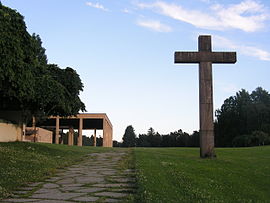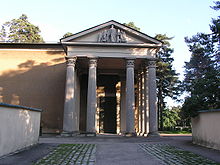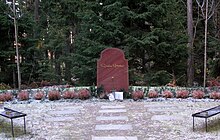Skogskyrkogården
Skogskyrkogården (German "forest cemetery") is a cemetery in the southern Stockholm district of Enskede . It was created and expanded by the Swedish architects Gunnar Asplund and Sigurd Lewerentz between 1917 and 1940.
History and description
Preliminary planning and competition
The first plans for the construction of a large cemetery in the southern part of Stockholm began in 1912. For this purpose, the city administration bought 85 hectares of land near Enskede, which was later increased to 108 hectares. The property mainly consisted of sand and gravel areas as well as a larger gravel pit and was overgrown with conifers . In 1915 an international architecture competition was announced for the design of the southern cemetery. The rules stipulated that the winner had to present a clear and as simply structured plan as possible, which did not require any major interventions in the landscape and which, above all, had to be dignified enough for a burial place. The necessary buildings should fit into this ensemble.
The architects Gunnar Asplund and Sigurd Lewerentz won the competition and were commissioned with the planning. Your proposal had the landscape as a starting point, to which the individual buildings and the tombs were subordinated. This took up the Nordic tradition of togetherness with nature.
Plant of the cemetery
Work on the cemetery began in 1917 with the construction of the actual cemetery area and the Skogskapellet (forest chapel), the first chapel designed by Gunnar Asplund. The only decoration of the otherwise simple forest chapel is the small, golden angel of death by the sculptor Carl Milles . In 1920 these first extensions were completed and the site was inaugurated. From 1923 to 1924 an administration building was built, which was also included in Asplund's plans and is known as the Tallum Pavilion . In 1925 the Uppståndelsekapellet (Resurrection Chapel) was built by Lewerentz, the second chapel in the cemetery.
In the 1930s, the stone wall that surrounds the site was built. Most of the stones came from the site itself. Unemployed people were committed to the city of Stockholm as workers, as there was massive unemployment in Sweden at that time. A third chapel was added to the crematorium ( Skogskrematoriet ) completed by Asplund in 1940 with the Heliga korsets kapell (Chapel of the Holy Cross). The crematorium and chapel, which actually consists of three individual small chapels, were built at the main entrance and also received a colonnaded vestibule , in which the sculpture The Resurrection (Uppståndelsemonumentet) by the sculptor John Lundqvist was placed. A pond and burial walls to hold the urns as well as a large granite cross , which was provided by an anonymous donor and also designed by Asplund, were built near these buildings . Work on the site was also finished in 1940, and the main architect Asplund died in the same year.
A path was laid from the buildings, which leads in an arch to the actual burial places. The artificial hill specially created by Lewerentz underlines the landscape of the site. This memorial (Meditationslund) crowned by elms is inspired by Caspar David Friedrich's landscape paintings and also has clear ancient elements. The tombstones themselves are between the trees. They are kept simple throughout, you will look in vain for monumental tombs in this cemetery.
Today's work on the site mainly concerns the constant care of the vegetation, with the pine forest in the foreground. All chapels have also been regularly renovated and are in good condition. The administration and maintenance is subject to the own committee for Skogskyrkogården in Stockholm, the work is financed by the city capital of Stockholm. No further expansions are currently planned, and there are also no plans that endanger parts of the site.
UNESCO World Heritage Site
Skogskyrkogården was added to the UNESCO World Heritage List in 1994 . According to UNESCO, Skogskyrkogården is an important example of our century for the fusion of architecture and cultural landscape into a cemetery . Skogskyrkogården has had a major impact on the design of burial sites around the world .
photos
people
The following people were buried in the cemetery:
- Gunnar Asplund (1885–1940), architect
- Greta Garbo (1905–1990), actress
- Ivar Lo-Johansson (1901–1990), writer
- Oscar AC Lund (1885–1963), silent film actor and director
- Lennart "Nacka" Skoglund (1929–1975), football player
- Birgit Cullberg (1908–1999), choreographer
- Otto Grimlund (1893–1969), Swedish journalist and communist politician
- Lars Gullin (1928–1976), jazz musician and orchestra leader
- Jan Johansson (1931–1968), jazz musician and composer
- Gunnar Wiklund (1935–1989), pop singer
- Avicii (1989–2018), DJ, producer and songwriter
See also
literature
- Claes Caldenby et al. a .: Asplund . Arkitektur Förlag, Stockholm 1985, ISBN 91-86050-12-5 .
Web links
Individual evidence
- ↑ Milles' Angel of Death is today a copy on the chapel roof; the original is exhibited in the visitor center.
Coordinates: 59 ° 16 '32 " N , 18 ° 5' 58" E













